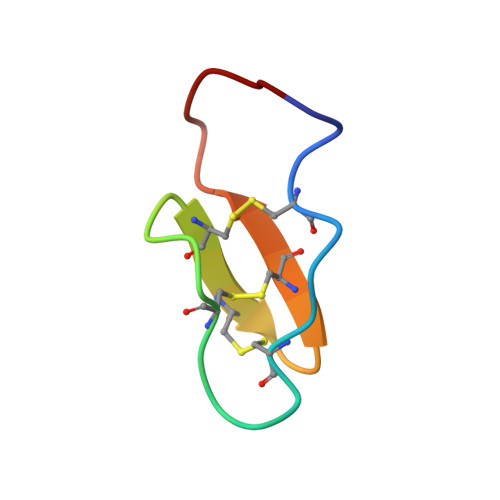Semienzymatic Cyclization of Disulfide-rich Peptides Using Sortase A.
Jia, X., Kwon, S., Wang, C.I., Huang, Y.H., Chan, L.Y., Tan, C.C., Rosengren, K.J., Mulvenna, J.P., Schroeder, C.I., Craik, D.J.(2014) J Biol Chem 289: 6627-6638
- PubMed: 24425873
- DOI: https://doi.org/10.1074/jbc.M113.539262
- Primary Citation of Related Structures:
2MH1 - PubMed Abstract:
Disulfide-rich cyclic peptides have generated great interest in the development of peptide-based therapeutics due to their exceptional stability toward chemical, enzymatic, or thermal attack. In particular, they have been used as scaffolds onto which bioactive epitopes can be grafted to take advantage of the favorable biophysical properties of disulfide-rich cyclic peptides. To date, the most commonly used method for the head-to-tail cyclization of peptides has been native chemical ligation. In recent years, however, enzyme-mediated cyclization has become a promising new technology due to its efficiency, safety, and cost-effectiveness. Sortase A (SrtA) is a bacterial enzyme with transpeptidase activity. It recognizes a C-terminal penta-amino acid motif, LPXTG, and cleaves the amide bond between Thr and Gly to form a thioacyl-linked intermediate. This intermediate undergoes nucleophilic attack by an N-terminal poly-Gly sequence to form an amide bond between the Thr and N-terminal Gly. Here, we demonstrate that sortase A can successfully be used to cyclize a variety of small disulfide-rich peptides, including the cyclotide kalata B1, α-conotoxin Vc1.1, and sunflower trypsin inhibitor 1. These peptides range in size from 14 to 29 amino acids and contain three, two, or one disulfide bond, respectively, within their head-to-tail cyclic backbones. Our findings provide proof of concept for the potential broad applicability of enzymatic cyclization of disulfide-rich peptides with therapeutic potential.
Organizational Affiliation:
From QIMR Berghofer Medical Research, Brisbane 4000, Queensland, Australia; Institute for Molecular Bioscience, University of Queensland, Brisbane 4072, Queensland, Australia.














